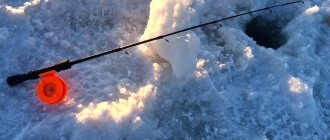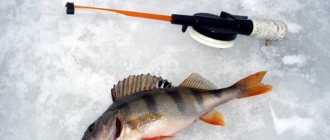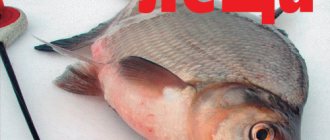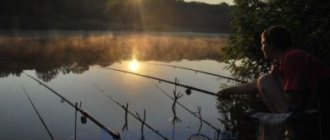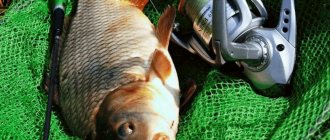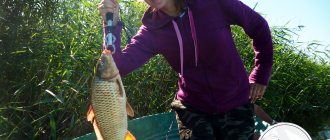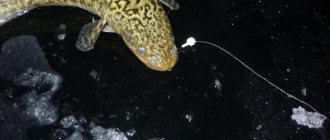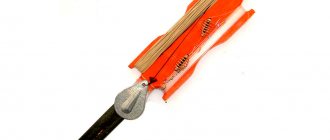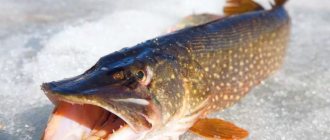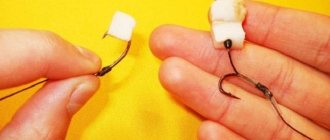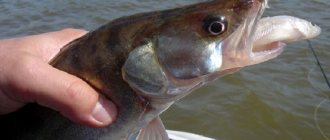Features of winter carp fishing
A peculiarity of carp is that it is less active in winter, which makes it difficult to catch. It’s worth getting ready for long fishing in the evening or at night.
Finding fish in the cold season is problematic, since carp in winter slows down the rhythm of its usual life, which means you should not feed it too much. Only properly selected complementary foods will ensure round-the-clock nibbling.
How to choose a place
The thickness of the ice in the chosen fishing location must be at least 1 m.
In winter, there are no permanent fish stops, so the main guideline in finding a place is water channels where there is no current. Winter fishing for carp will be successful in ponds with running water, in deep areas of reservoirs, or just beyond a river bend. The boundary between flowing and standing water can serve as a convenient haven for fish.
The carp differs from other freshwater fish in that it tries not to appear in places with fast currents and swims at great depths. Often carp and silver carp live in the same place. This can be used when searching for fish. The adult prefers to look for food in places with a high oxygen content in the water.
What is the best time to catch carp in winter?
At very low temperatures, winter fishing becomes more difficult as fish sink to the bottom to wait out the harsh conditions. Therefore, the best time to catch carp in winter is the onset of warm and clear weather with light winds. Water cooled to +5°C is the most comfortable environment for fish. Catching carp is also made more difficult by the fact that the fish sinks to medium depths and swims away from the shore, occupying places where algae and water lilies grow in summer.
Where to catch carp in winter
Fishing locations are usually selected during the open water season. Carp prefers deep places with current. Therefore, even in winter, you need to look for it in such places. The main condition when choosing a fishing spot is the presence of some kind of edge in a deep hole or a relatively shallow spot in the middle of a depth of 7-10 meters. And it’s best when there are shell rocks on this edge. Carp often prefers to feed on bivalve mollusks and barley mollusks; pearl barley is often its main food, since these large fish and food require larger volumes.
On the channels of the Volga delta, it is, of course, much easier to find carp. In eriks, places for successful fishing are reed thickets along the banks and a deep riverbed edge with a current. In the first ice and in the spring there is quite an intense carp bite here, almost like in the summer.
In winter, on large reservoirs, it makes no sense to wait for the carp to bite early in the morning, at the so-called fishing dawn. Most likely, its short bite may begin around eleven o’clock or even later. All this must be clarified experimentally. Closer to spring, carp begins to move to river mouths, where it can accumulate in large quantities.
Winter tackle for carp
Often the fish circles and tangles the line, so the tackle must have a safety margin that can withstand constant loads. When fishing in the cold season, it is worth fishing with a short winter fishing rod. Experienced fishermen recommend using fishing line up to 0.3 mm. You can use a float, but some anglers prefer nodding gear for winter fishing.
Rod
It is advisable to choose specialized fishing rods for float fishing. The length ranges from 20 to 50 cm. It is easier to catch large fish with a fishing rod with a high safety margin that can withstand strong resistance.
Coil
Fishing for carp will be more comfortable with a multiplier or spinning reel. Such tackle will provide effective shock absorption of strong pulls on the prey. In severe frost, the coil is lubricated to avoid excessive friction and premature wear of parts.
fishing line
In winter, the water in rivers and lakes becomes transparent, so the thickness of the fishing line must be selected so that it is invisible to fish eyes. The diameter of the fishing line should be from 0.2 to 0.3 mm. Professional fishermen advise using monofilament fishing line, which is not afraid of the harsh conditions of winter fishing.
When fishing without a float, you need to constantly keep the line taut, because bites from the carp family are characterized by sharp and powerful shocks, which can be noticed if the alarm is working correctly.
How to catch carp in winter on a pond from ice
Winter fishing for carp from ice on a pond or river has many features in comparison with fishing for other species of underwater inhabitants (Figure 6).
To improve your fishing performance, follow these tips:
- When fishing, you should take an ice screw with a diameter of 130-150 mm. The fact is that carp is a fairly large fish with a rounded body, and it simply will not fit into a small hole. For the same reason, it is better to take a hook with you, which you can use to hold the fish while your assistants widen the hole.
- Keep in mind that bites in winter are very weak, so you will have to hook prey even with the slightest movement of the float or nod.
- If you manage to hook a fish, try not to make sudden movements and immediately bring the prey to the hole. Try to ensure that the carp gets tired of hooking. To do this, gradually lower the line and then pull it up again.
- Using bait significantly increases fishing performance. But try not to overfeed the fish too much, as a well-fed carp simply will not bite the bait. In this case, it is advisable to add a little bait to the hole every 30-40 minutes.
Figure 6. The technique of winter carp fishing includes many nuances.
If there are no bites for a long time, try changing the hook and fishing line to thinner ones. It is possible that you are using too visible gear, and the carp simply eats the bait without affecting the bait.
In addition, experienced fishermen recommend drilling not one, but several holes at once, and periodically moving from one to another in the absence of bites. It is also necessary to shade the holes by simply sprinkling them with snow, since bright light will easily scare away prey. You can also use regular cardboard, plywood or pieces of tarpaulin for shading.
Montages used
In winter, gear for catching carp can be selected based on the individual preferences of the fisherman, but there are also general rules for their manufacture.
For comfortable fishing, it is recommended to use small-sized float tackle (30-40 mm) of the “wagler” or sliding type. This gear is suitable for warm weather. If there is severe frost, then a “tablet” type float is indispensable. When fishing at night, it is easiest to observe a float that is snow-white or bright yellow.
Fishermen recommend using medium-sized hooks (No. 9−12) when fishing for carp. A spoon with a jig can be an excellent tool that replaces the usual hook.
Carp in winter
The carp becomes passive in winter and goes to deep parts of the reservoir, but it does not bury itself in silt, does not hibernate, and continues to feed periodically. The time of the most active feeding of winter carp can only be determined in a specific reservoir. It happens that in different flowing ponds with approximately the same natural conditions, located several kilometers from each other, carp feeding periods occur at different times of the day. Throughout the winter, the carp's behavior changes as weather conditions change.
What bait to use
The bite depends on both the quality of the bait and the quality of the gear.
There is a high probability of catching a carp on a balance beam, because an adult often hunts for small fish. Some fishermen use boilies, but this method is not always effective. In spring, carp bite on corn and shrimp meat.
Lard and dough are still the favorite baits of fishermen. The lard must be fresh and pre-soaked in water. The dough is made from rye or wheat flour based on milk. Honey or egg yolk can be added as an additive.
The following baits are traditionally used:
- boiled corn;
- bread crumb;
- bloodworm or maggot;
- boiled potatoes.
Bait
For successful fishing, you need to select the appropriate bait and bait for the fish, the fish will react most actively.
The bait should attract fish, but not allow them to get enough of it. The amount of bait should not exceed 300 g per day. You can prepare bait yourself or purchase factory-made bait from a specialized fishing store.
The following can be used as bait to attract carp in winter:
- Bloodworm.
- Breadcrumbs.
- Chopped worms.
It is mandatory to add an appetite stimulant to the bait, which attracts fish with a keen charm. Feeding the fish should last from 1 to 4 days to completely get used to the feeding place.
The following baits can be used for catching carp:
- bloodworm;
- caddisfly;
- bark beetle;
- maggot;
- canned corn;
- green peas;
- barley;
- shrimp;
- crayfish meat;
- semolina mash;
- boiled potatoes
Fishermen prepare their own dumplings for catching carp, or buy boilies.
Boilies for fishing in winter include:
- “Natural Food” mixture – 1 tablespoon (tablespoon);
- attractant “Wild Milk” - 5 ml;
- sweetener "Mega Sweetener" - 3 ml;
- chicken egg -5 pcs.;
- fish meal “Mahin Protein Mix” - 500 g;
- appetite stimulant “Appetit Stimulator Fruit” - 1 tablespoon (tablespoon);
- attractant “Tutti Frutti” - 5 ml.
First, a mixture is prepared from all the components, which is mixed well until a homogeneous mass is obtained. Roll the resulting mixture into balls with a diameter of 1.5–2.0 cm and place in boiling water for 2 minutes. and removed for cooling. Later, when fishing, balls (boilies) are used for bait when fishing for carp.
When going fishing, you need to take with you various bait and, through experimentation, select the one that most actively attracts fish.
Techniques for catching carp in winter
Fishing technique: bait is placed on the hook, the equipment is immersed in the hole and touches the bottom. The float is fixed at the required depth, and the fishing rod is placed on the ice next to the hole in anticipation of a bite. Using tackle with a retractable leash involves moving the float to the side.
Carp feels uncomfortable at low temperatures, so on warm winter days when the air temperature is above zero, the fish swims out of deep holes. At such moments, you need to try to feed several holes. To prevent the fish from losing interest, constantly add complementary foods in small quantities. But you can’t overdo it with bait, because a well-fed carp will swim away.
Biting and fishing
The biting and fishing of this type of fish is unusual.
The entire cyprinid family has well-developed olfactory organs, so obtaining food and finding bait for these fish does not take much time.
The main thing is to learn to distinguish a bite from rare twitching of the float. If the float takes a horizontal position, it is worth sharply but carefully hooking the fish at the same moment. It is also necessary to hook if the float is pulled to the side or pulled under the water.
After hooking, these fish try to escape the impending danger to their shelter. And it is almost impossible to catch carp from such shelters.
What baits are used when catching winter carp
In the cold season, complementary foods should be used in small portions, because the activity of carp in winter is low. If bites occur frequently, it is worth reducing the amount of complementary foods. 90% of complementary foods may consist of inedible components. The filler is ground clay, sand or damp earth.
Summer boilies are also suitable for bait. Fishing stores have a large selection of ready-made mixtures. When preparing it yourself, various flavorings and flavoring additives are used. Sunflower cake is an example of the most effective complementary feeding.
Catching carp in winter with a jig
Now a little about fishing with a jig, which some people prefer over float tackle. Some, of course, successfully catch carp both on a feeder in winter and on a spoon and even on a jig, but the jig remains the most popular tackle. Many novice fishermen make a very big mistake when they use gear designed to catch carp weighing more than two kilograms. When fishing for carp, the main fishing rule applies - the thinner the tackle, the better. Some anglers say that thick line does not deter carp. But, most likely, this only happens in artificial ponds, in which the abundance of fish simply makes them grab everything that falls into the water. So, what I mean by this, if you plan to catch a not very large carp, weighing about two kilograms, then a braided cord with a diameter of 0.1 - 0.12 mm will be quite enough.
If you look a little more closely at the gear for catching carp with a jig, you will notice that they are very similar to the gear for catching bream in winter. The main thing is a long enough nod. Carp bites can occur in different ways, but most often it, like bream, raises a nod. There are no special jigs for carp, so there is no need to look for them on the shelves of fishing stores, just buy or make large oats or pellets yourself.
The key factor in catching carp with a jig is the bait. This is an individual matter and you need to choose bait depending on the fishing conditions. In some reservoirs, carp catch well on corn, peas or dough, while in others it is better to catch it on bloodworms or maggots. So before choosing bait, answer yourself the question of what the carp bite on in your pond. Don’t forget to experiment, because very often you have to catch fish with so-called sandwiches (a combination of different baits on a hook).
The situation is the same with bait, because winter fishing is simply impossible without it. It all depends not only on the reservoir, but also on the fisherman himself. After all, some prefer store-bought bait, while others like to prepare it themselves. In any case, you need to be very careful not to overfeed the fish and use significantly less bait than in the summer.
The carp bite on a jig is very sluggish and sometimes difficult to notice. But if you still notice it and hook the fish in time, then the most interesting part begins - fishing. Pulling out a carp weighing less than a kilogram from a hole will not be difficult, but fishing for trophy specimens is exciting and requires the fisherman to have certain skills. The first jerks of the carp are considered the most powerful, after which you need to slowly lead it to the hole, the main thing is not to fuss and not to rush.
Catching carp with a jig in winter is not a very simple task, which requires certain knowledge from the fisherman. Do not forget that it is best to darken the hole with snow. Bagorik needs to be prepared in advance. Because if it is not there, then the fisherman will have to undergo an unpleasant procedure - stick his hand into the hole and pull out the fish. On thin ice it is quite simple, but on thick ice it is completely different.
Read Catching catfish with kwok
Jigs for carp
Carp are caught in winter using regular hooks, but it is best to use jigs. You won’t find special jigs for carp fishing on store shelves, but don’t be upset. Any nozzles with a large diameter, about 5 mm, will do. The best and catchiest jigs are considered to be Uralka, pellet and crystal. But it depends on your pond.
Retrieving a jig when fishing for carp
The best retrieve is considered to be weak shaking of the jig at the very bottom. Don’t forget about pauses, sometimes they need to be done for a few seconds, and sometimes even for 5 minutes. Tapping on the bottom attracts most fish, but carp are an exception. You need to place the jig on the bottom smoothly and carefully. The jig should be raised from the bottom no more than 20 centimeters, or simply moved slightly.
Who is carp?
Carp belongs to the freshwater commercial fish species from the carp family. The river carp looks quite beautiful, with unusual large dark yellow-golden scales, dark on the back and light, with a bluish tint, on the belly. At first glance, carp, especially young individuals, resemble crucian carp, but carp are not as high in the dorsal region as crucian carp. Upon closer examination, you will notice that the body of the carp is thicker and longer, with 4 prominent antennae on yellow and rather fleshy lips, which are almost as motionless as those of a bream. The common dorsal fin, dark gray in color, is somewhat wider than that of other representatives of the cyprinid family. In addition to its large width, this fin has a very strong, saw-toothed, jagged front ray, like that of the longhorned myron. Carp has well-developed senses of smell and touch. The size of the carp depends mainly on the area of the reservoir in which it lives. The weight of carp usually reaches 1-2 kg, but sometimes there are specimens weighing more than 20 kg. Carp live for about 30-35 years.
[custom_ads_shortcode2]
Where to look for carp in winter
Adapting to local climatic conditions, carp independently divided into many subspecies. For example, the Altai carp has noticeable external differences compared to its European relative. Conditionally generalizing its behavior, it can be noted that during the period of freeze-up, the fish spend a long time in deep holes on the boundaries of fast and insignificant currents. This is typical for flowing ponds, lakes and river bays. In winter, carp is often found in deep areas near reed thickets, as well as near existing underwater springs.
During the process of ice formation, wild carp can approach unfrozen areas, provided there is no strong current. At the end of winter, when the ice gradually moves away from the shore, carp, along with silver crucian carp, can go to smaller places in the coastal zone.
The feeding periods of winter carp are short: about 30 minutes. May be repeated throughout the day. It feeds for a longer period of time with the onset of thaws on clear sunny days. In the dead of winter, when severe frosts set below -15 degrees, the carp becomes almost motionless and stops feeding. In such conditions, only a bottom larva that accidentally comes under the nose becomes food.
